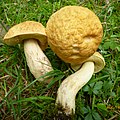| Image | Scientific name | Taxon author | Year | Distribution |
|---|
| Leccinellum aberrans | (J. Blum) C. Hahn | 2020 (1970) | United States |
 | Leccinellum albellum | (Peck) Bresinsky & Manfr. Binder | 2003 (1888) | Hidalgo, Mexico, USA |
| Leccinellum alborufescens | N.K. Zeng, R. Xue & S. Jiang | 2019 | China (Hainan) |
| Leccinellum castaneum | Yan C. Li & Zhu L. Yang | 2021 | China |
| Leccinellum citrinum | Yan C. Li & Zhu L. Yang | 2021 | China |
 | Leccinellum corsicum | (Rolland) Bresinsky & Manfr. Binder | 2003 (1896) | Mediterranean Europe and North Africa |
| Leccinellum cremeum | Zhu L. Yang & G. Wu | 2016 | China |
 | Leccinellum crocipodium | (Letell.) Bresinsky & Manfr. Binder | 2003 (1835) | Belgium, France |
| Leccinellum fujianense | N.K. Zeng, R. Xue & Zhi Q. Liang | 2019 | China (Fujian) |
| Leccinellum griseopileatum | Yan C. Li & Zhu L. Yang | 2021 | China |
 | Leccinellum griseum | (Quél.) Bresinsky & Manfr. Binder | 2003 (1901) | United States |
| Leccinellum indoaurantiacum | D. Chakr., K. Das, Baghela, S.K. Singh & Dentinger | 2016 | India (Sikkim) |
 | Leccinellum lepidum | (H. Bouchet ex Essette) Bresinsky & Manfr. Binder | 2003 (1965) | Corsica, Croatia, Cyprus, France and Greece |
| Leccinellum luteoporum | (Bouchinot) Blanco-Dios | 2018 (1904) | Europe |
| Leccinellum luteoscabrum | (Schiffn.) Bresinsky & Manfr. Binder | 2003 (1922) | |
| Leccinellum luteum | (A.H. Sm., Thiers & Watling) Mikšík | 2019 (1967) | Canada |
| Leccinellum onychinum | Fang Li, Kuan Zhao & Qing Li Deng | 2016 | |
 | Leccinellum pseudoscabrum | (Kallenb.) Mikšík | 2017 (1929) | northern and central Europe. |
 | Leccinellum quercophilum | M. Kuo | 2013 | United States |
| Leccinellum rhodoporosum | (Har. Takah.) Har. Takah. | 2016 (2007) | |
 | Leccinellum rugosiceps | (Peck) C. Hahn | 2020 (1905) | Asia, North America, Central America, and South America |
| Leccinellum sinoaurantiacum | (M. Zang & R.H. Petersen) Yan C. Li & Zhu L. Yang | 2021 (2001) | China |
| Leccinellum tlemcenense | (Maire) C. Hahn | 2020 (1907) | |
| Leccinellum viscosum | (Halling & B. Ortiz) Mikšík | 2016 (2009) | Belize |
|








